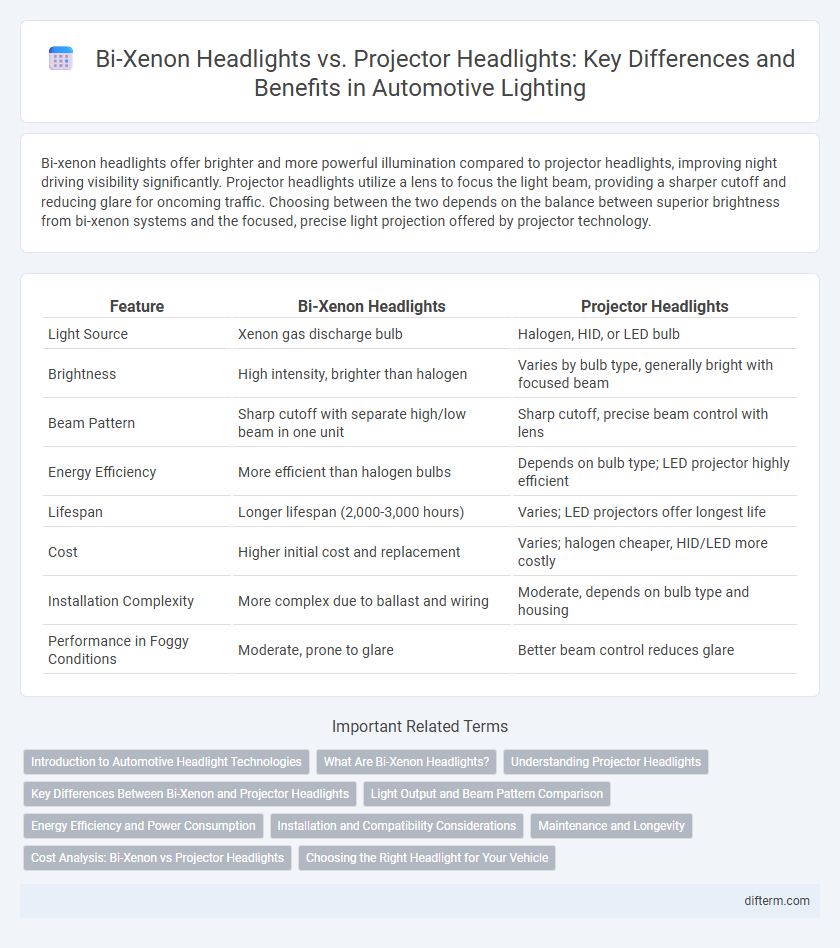Bi-xenon headlights offer brighter and more powerful illumination compared to projector headlights, improving night driving visibility significantly. Projector headlights utilize a lens to focus the light beam, providing a sharper cutoff and reducing glare for oncoming traffic. Choosing between the two depends on the balance between superior brightness from bi-xenon systems and the focused, precise light projection offered by projector technology.
Table of Comparison
| Feature | Bi-Xenon Headlights | Projector Headlights |
|---|---|---|
| Light Source | Xenon gas discharge bulb | Halogen, HID, or LED bulb |
| Brightness | High intensity, brighter than halogen | Varies by bulb type, generally bright with focused beam |
| Beam Pattern | Sharp cutoff with separate high/low beam in one unit | Sharp cutoff, precise beam control with lens |
| Energy Efficiency | More efficient than halogen bulbs | Depends on bulb type; LED projector highly efficient |
| Lifespan | Longer lifespan (2,000-3,000 hours) | Varies; LED projectors offer longest life |
| Cost | Higher initial cost and replacement | Varies; halogen cheaper, HID/LED more costly |
| Installation Complexity | More complex due to ballast and wiring | Moderate, depends on bulb type and housing |
| Performance in Foggy Conditions | Moderate, prone to glare | Better beam control reduces glare |
Introduction to Automotive Headlight Technologies
Bi-xenon headlights use xenon gas and high voltage to produce bright, efficient light with both low and high beams in a single bulb, enhancing visibility and safety. Projector headlights utilize a lens to focus the light beam sharply, reducing glare for oncoming drivers and offering superior beam control. Both technologies represent significant advancements over traditional halogen headlights, improving nighttime driving performance and energy efficiency in modern vehicles.
What Are Bi-Xenon Headlights?
Bi-xenon headlights use high-intensity discharge (HID) bulbs to provide both low and high beam functions through a single light source, delivering brighter and more efficient illumination compared to traditional halogen lamps. Equipped with a mechanical shutter or projector lens, these headlights quickly switch beam patterns to enhance visibility and reduce glare for oncoming traffic. Their superior light output and sharp cutoff lines improve nighttime driving safety and overall road visibility in modern automotive lighting systems.
Understanding Projector Headlights
Projector headlights use a compact, precise lens system to focus light onto the road, producing a sharper and more controlled beam pattern compared to bi-xenon headlights. These headlights enhance nighttime visibility by reducing glare for oncoming drivers and providing better illumination of road edges and signs. Their design typically incorporates halogen, HID, or LED light sources, allowing for improved efficiency and longevity in automotive lighting systems.
Key Differences Between Bi-Xenon and Projector Headlights
Bi-xenon headlights use xenon gas discharge bulbs that provide brighter, more intense light with higher visibility compared to conventional halogen projectors. Projector headlights refer to the lens design focusing and directing light beam precisely, which can be paired with halogen, HID, or LED bulbs, offering improved beam control and reduced glare. Bi-xenon headlights combine high-intensity discharge technology with projector lenses for superior brightness, sharper cutoff lines, and enhanced nighttime driving safety.
Light Output and Beam Pattern Comparison
Bi-xenon headlights produce a brighter, more intense light output compared to standard projector headlights, significantly enhancing nighttime visibility with their high-intensity discharge bulbs. The beam pattern of bi-xenon systems offers a sharper cutoff line, minimizing glare for oncoming traffic while delivering a more focused and evenly distributed light spread. Projector headlights, although efficient, generally provide a less intense beam and softer cutoff, resulting in reduced clarity and distance coverage under low-light driving conditions.
Energy Efficiency and Power Consumption
Bi-xenon headlights offer higher energy efficiency by producing brighter light using less power compared to traditional halogen projector headlights. Their advanced xenon gas discharge technology converts electrical energy into intense, focused illumination, reducing overall power consumption in automotive lighting systems. Projector headlights, while effective in beam control, typically consume more energy due to halogen bulbs, making bi-xenon systems a preferable choice for vehicles aiming to optimize energy use and battery longevity.
Installation and Compatibility Considerations
Bi-xenon headlights often require a compatible ballast and wiring harness for proper installation, making them more complex to fit into vehicles not originally equipped for them. Projector headlights, designed with integrated lens systems, offer easier installation with standard wiring but may need specific housing sizes to fit correctly. Compatibility with vehicle makes and models should be verified to ensure seamless integration and optimal lighting performance.
Maintenance and Longevity
Bi-xenon headlights offer longer lifespan and require less frequent bulb replacements compared to traditional projector headlights, making them more cost-effective for maintenance. Projector headlights, while easier to replace due to simpler technology, often experience quicker wear and may need more frequent alignment and cleaning to maintain optimal performance. Investing in bi-xenon headlights reduces long-term maintenance efforts thanks to their durable arc discharge mechanism and higher efficiency.
Cost Analysis: Bi-Xenon vs Projector Headlights
Bi-xenon headlights generally incur higher initial costs than projector headlights due to their advanced gas-discharge technology and superior brightness, often ranging between $300 to $700 per unit. Projector headlights, utilizing halogen or LED bulbs with a focused beam pattern, typically cost between $100 and $300, offering a more budget-friendly option without compromising on beam precision. When considering long-term expenses, bi-xenon headlights often require more specialized maintenance and bulb replacements, while projector headlights benefit from lower upkeep costs and greater compatibility with aftermarket upgrades.
Choosing the Right Headlight for Your Vehicle
Bi-xenon headlights deliver intense, bright white light with excellent range and visibility, making them ideal for high-speed driving and enhanced nighttime safety. Projector headlights offer a focused, sharp beam pattern that reduces glare for oncoming traffic and improves overall road illumination. Selecting the right headlight depends on your driving conditions, vehicle type, and preference for light intensity versus beam precision.
bi-xenon headlights vs projector headlights Infographic

 difterm.com
difterm.com